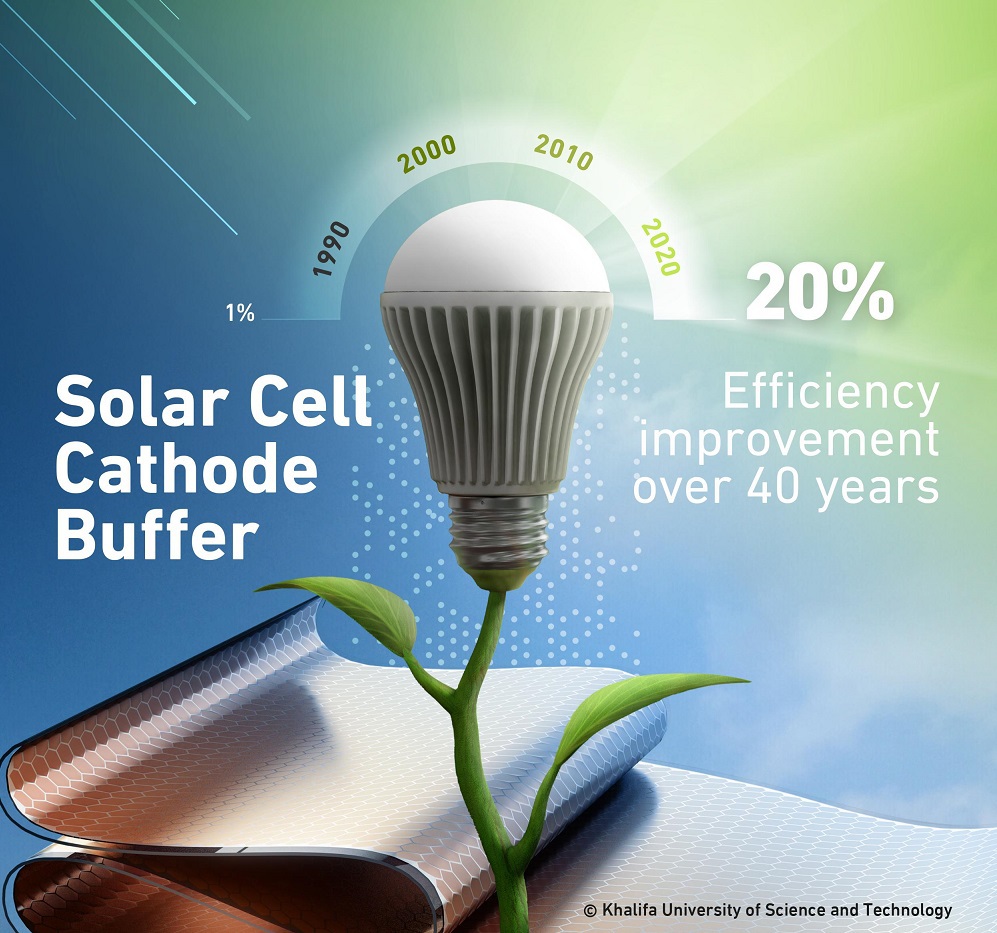
A review paper by Khalifa University and a team of international scientists advances understanding of the latest developments underway to improve the performance and cost of flexible, polymer solar cells
On the roadmap of the world’s transition to clean energy, solar power leads the way. Every day, the sun releases more energy than humanity needs to power everything on Earth, but tapping into that power remains the challenge. Photovoltaics are electronic devices that convert sunlight into electricity, and while their cost has plummeted recently due to intense interest, challenges remain.
Researchers from Khalifa University have collaborated with a team of international researchers to conduct a review of cathode buffer layers used in organic solar cells. Their review paper, which was published in Advanced Materials Interfaces, explains the advances researchers have made in recent years in materials science to improve the overall efficiency and lifetime of this type of photovoltaic.
Dr. Vinay Gupta and Dr. Shashikant Patole, both Assistant Professors in the Khalifa University Department of Physics, undertook their review in collaboration with researchers from the CSIR-National Physical Laboratory, India, Swansea University, United Kingdom, and the University of Jammu, India.
An organic solar cell is a type of photovoltaic that uses conductive organic polymers to absorb light and produce electricity from sunshine. Most organic photovoltaic cells are polymer solar cells.
Compared to silicon-based devices, polymer solar cells are lightweight, flexible, customizable on the molecular level and inexpensive to fabricate. But these advantages are balanced by their disadvantages: they offer about one third of the efficiency of other materials and experience substantial photochemical degradation.
“The high costs involved in inorganic photovoltaic materials have prevented these technologies from having a significant impact on global energy production,” Dr. Gupta said. “Organic photovoltaics like pervoskite solar cells (PSCs) and dye-sensitized solar cells (DSSCs) are being studied as potential alternatives, but they suffer from drawbacks including low power conversion efficiency and a short lifespan with real sensitivity to the environment.”
One way to improve the efficiency is to evolve the solar cell’s structure using buffer layers at the anode and the cathode. For their work, the research team focused on the cathode buffer layer (CBL), investigating architecture, materials and mechanisms of action to provide detailed insight into the opportunities for CBL improvement.
“The primary role of a CBL is to facilitate the collection of electrons at an electrode,” Dr. Patole said. “But it also performs several other tasks in making a solar cell function smoothly, including forming an electron selective and transport interlayer, blocking reverse charge carriers, and protecting the active layer from the hot metal atoms during thermal deposition of the cathode. For efficient organic solar cells, selecting an appropriate and high quality CBL is crucial.”
Per the researchers’ findings, an ideal CBL should be good at electron extraction and transport; have a suitable energy level that facilitates electron transport with high transparency and stability; and offer compactness for use in lightweight, flexible organic solar cells. One such material used is titanium oxide, a semiconducting metal oxide favored for its unique optical properties. Research has also found that adding cesium into the titanium oxide mix further improved device performance, while zinc oxide and zirconium oxide have also been studied.
“A diverse variety of organic materials, including conjugated polymers and small molecules, have also been explored as CBL in organic solar cells,” Dr. Gupta said.
“Small molecule-based layers offer advantages thanks to their well-defined molecular weight and the easy purification process. Quantum dots have also been explored because of their tunable optical and electrical properties, however, their commercial application is hindered by their sensitivity to the environment. Still, they remain interesting as an emerging class of nanomaterials with unique properties.”
The research team found that oxides and carbonates are popular as CBLs in organic solar cells, with zinc oxide one of the most widely used CBLs in high efficiency solar cells thanks to its chemical and thermal stability, favorable electronic and optical properties, and its low-cost fabrication. Metal and alkali fluorides, including calcium, barium, and lithium, are also popular as they improve performance in extracting electrons.
Additionally, organic solar cells can only harness sunlight from a narrow range of the electromagnetic spectrum, as ultraviolet and infrared photons can degrade the photoactive layer.
While CBLs can be used to resolve these issues and increase the lifetime of the devices, a CBL would need to perform dual functions, performing its duties at the cathode level and also in protecting the photoactive layer.
It is clear from the review paper that further improvements in performance are needed to allow polymer solar cells to compete with silicon cells, but efforts are being made to improve their viability in the photovoltaic market. The research offered by the team in their review paper will help researchers around the world develop these high efficiency cathode buffer layers for improved organic solar cell devices.
Jade Sterling
Science Writer
31 March 2022






